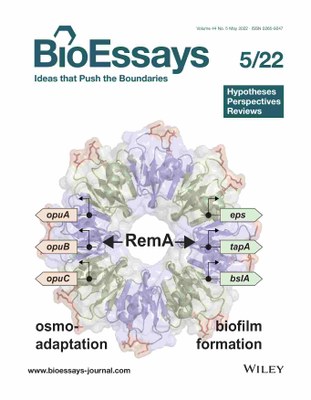Hauptinhalt
Reviews

27. Bremer E., Hoffmann T., Dempwolff F., Bedrunka P., Bange G. (2022) The many faces of the unusual biofilm activator RemA. Bioessays. 2022 Mar 15; e2200009. (PDF)

26. Bremer, E. (2020) Masters of Change [Editorial]. Biol. Chem. 401:1305-1306. (PDF)
Titel page of a Special Issue of Biol Chem contributed by members of the DFG-funded CRC Research Consortium 987 (https://www.degruyter.com)
25. Hermann, L., Mais C.-N., Czech L., Smits H.J., Bange G., Bremer E. (2020) The ups and downs of ectoine: structural enzymology of a major microbial stress protectant and versatile nutrient. Biol. Chem. 401:1443-1468. (PDF) (Suppl)
24. Czech L., Hoeppner A., Smits H.J., Bremer E. (2020) Ectoine synthase: an iron-dependent member of the cupin superfamily. In: A. Messerschmidt (Ed) Encyclopaedia of Inorganic and Bioinorganic Chemistry (e Edition) DOI:10.1002/9781119951438.eibc2742. (PDF)
23. Bremer E., Krämer R. (2019) Responses of microorganisms to osmotic stress. Annu. Rev. Microbiol. 73:313-34. (PDF)
22. Czech L., Hermann L., Stöveken N., Richter A.A., Höppner A., Smits S., Heider J., Bremer E. (2018) Role of the extremolytes ectoine and hydroxyectoine as stress protectants and nutrients: genetics, phylogenomics, biochemistry, and structural analysis. Genes 22: 9,177. (PDF)
21. Czech L., Bremer E. (2018) With a pinch of extra salt - did predatory protists steal genes from their food? PLoS Biol 16: e2005163. (PDF)
20. Bremer E. (2017) Clostridium difficile: a bad bug goes into defensive mode. Env. Microbiol. 19: 2523-2528. (PDF)

19. Hoffmann T., Bremer E. (2017) Guardians in a stressful world: the Opu family of compatible solute transporters from Bacillus subtilis. Biol. Chem. 398: 193-214. (PDF) Titelbild des Journal "Biological Chemistry" im Zusammenhang mit dem oben genannten Artikel
18. Hoffmann T., Bremer E. (2016). Management of osmotic stress by Bacillus subtilis: genetics and physiology. In: (Ed.: F. de Bruijn) Stress and Environmental control of gene Expression in Bacteria. Wiley/Blackwell p. 657-676 (Link zu Wiley) (PDF)
17. Widderich N., Bremer E., Smits SHJ. (2016) The ectoine hydroxylase: a non-heme-containing iron (II) and 2-oxoglutarate-dependent dioxygenase. In: A. Messerschmidt (Ed) Encyclopaedia of Inorganic and Bioinorganic Chemistry (e Edition) DOI:10.1002/9781119951438.eibc2440. (PDF)
16. Bremer, E. (2014) Liberate and grab it, ingest and digest it: the GbdR regulon of the pathogen Pseudomonas aeruginosa. J. Bacteriol. 196: 3-6. (PDF)
15. Hoffmann, T. and Bremer, E. (2013) Osmoregulation: Prolin - vielfältig wie ein Schweizer Taschenmesser. BIOspektrum 19 (7): 723-725. (PDF)
14. Pittelkow, M. and Bremer (2011). Cellular adjustments of Bacillus subtilis and other Bacilli to fluctuating salinities. In: Halophiles and Hypersaline Environments: Current Research and Future Trends. (Eds. A. Ventosa, A. Ohren and Y. Ma). (Springer, Berlin; 1st Edition), S. 275-302. (PDF)
13. Bremer, E. (2011) A look into the aromatic cage. Crystal Ball-2011. Env. Microbiol. Rep.3:1-5. (PDF)

12. Ziegler, C., Bremer, E. and Krämer, R. (2010). The BCCT-family of carriers: from physiology to crystal structure. Mol Microbiol. 78: 13-34. (PDF) Titelbild des Journal "Molecular Microbiology" im Zusammenhang mit dem oben genannten Artikel
11. Horn, C., S. Jenewein, L. Sohn-Bösser, E. Bremer and L. Schmitt. (2005). Biochemical and structural analysis of the Bacillus subtilis ABC-transporter OpuA and its isolated subunits. J. Mol. Microbiol. Biotechnol. 10:76-91. (PDF)
10. Holtmann, G., C.D. Boiangiu, J. Brill, T. Hoffmann, A.U. Kuhlmann, S. Moses, G. Nau-Wagner, N. Pica and E. Bremer (2004). Physiological and molecular responses of Bacillus subtilis to hypertonicity: utilization of evolutionarily conserved adaptation strategies. In: Halophiles (Ed.: A. Ventosa). Springer-Verlag, Heidelberg; p. 115-134. (PDF)
9. Wood, J. M., E. Bremer, L. N. Csonka, R. Krämer, B. Poolman, T. van der Heide and L. T. Smith. (2001). Osmosensing and osmoregulatory compatiblesolute accumulation by bacteria. Comp. Physiol. Biochem. 130:437-460. (PDF)
8. Bremer, E. (2001). Adaptation to changing osmolarity. In: Bacillus subtilis and its closest relatives: from genes to cells. (Ed.: A.L. Sonnenshein, R. M. Losick and J. A. Hoch) American Society for Microbiology. ASM Press, Washington D. C.; p. 385-391. (PDF)
7. Bremer, E. and R. Krämer (2000). Coping with osmotic challenges: osmoregulation through accumulation and release of compatible solutes. In "Bacterial Stress Responses" (Eds. G. Storz and R. Hengge-Aronis). American Scociety for Microbiology. ASM Press, Washington D. C.; p. 79-97. (PDF)
6. Kempf, B. and E. Bremer (2000). Water-deficient environments. In "Encyclopedia of Microbiology". (Ed. J. Lederberg). Academic Press (San Diego; USA.). Vol. 4 (Second Edition); p. 884-897. (PDF)
5. Kempf, B. and E. Bremer. (1998). Uptake and synthesis of compatible solutes as microbial stress responses to high osmolality environments. Arch. Microbiol. 170:319-330. (PDF)
4. Kempf, B. and E. Bremer. (1998). Stress responses of Bacillus subtilis to high osmolarity environments: uptake and synthesis of osmoprotectants. J. Biosci. 23:447-455. (PDF)
3. Lucht, J.M. and E. Bremer. (1994). Adaptation of Escherichia coli to high osmolarity environments: osmoregulation of the high-affinity glycine betaine transport system ProU. FEMS Microbiol. Rev. 14:3-20. (PDF)
2. Dersch, P., J.M. Lucht und E. Bremer. (1994). Einfluß des Nucleoid-assoziierten DNA-Bindeproteins H-NS auf die bakterielle Genexpression. In: Modulation der Virulenz von Mikroorganismen (Eds: J. Hacker und J. Heesemann), "Upjohn Bibliothek"; p. 7-21.
1. Benson, S.A, E. Bremer, S. Garrett, D.R. Kiino, J.W. Schultz, T.J. Silhavy, E.J. Sondergren, R.K. Taylor and N.J. Trun. (1984). Mechanisms of cellular protein localisation. In: E. Haber (ed), The cell membrane. Plenum Publishing Corporation; p. 131-146.